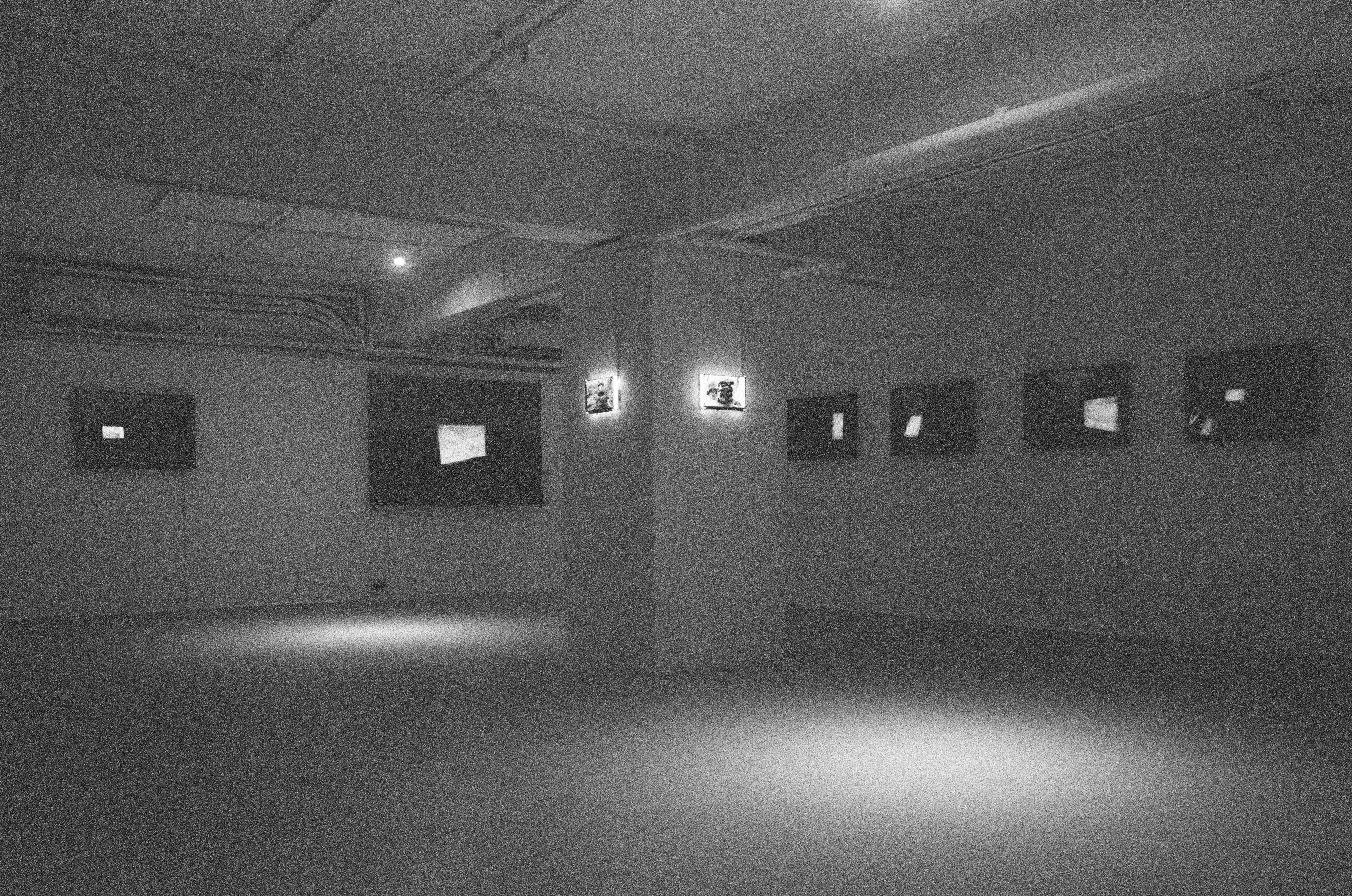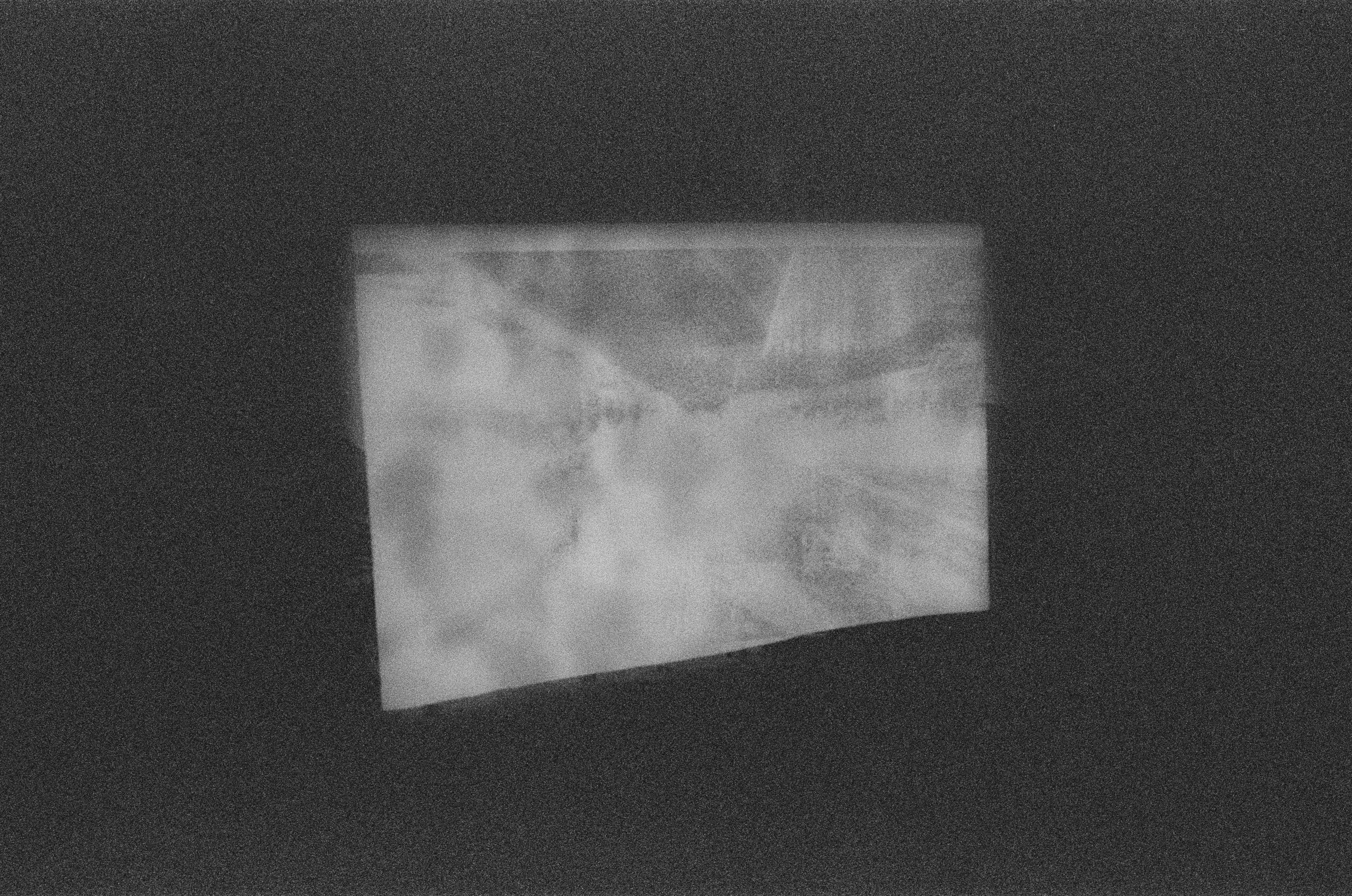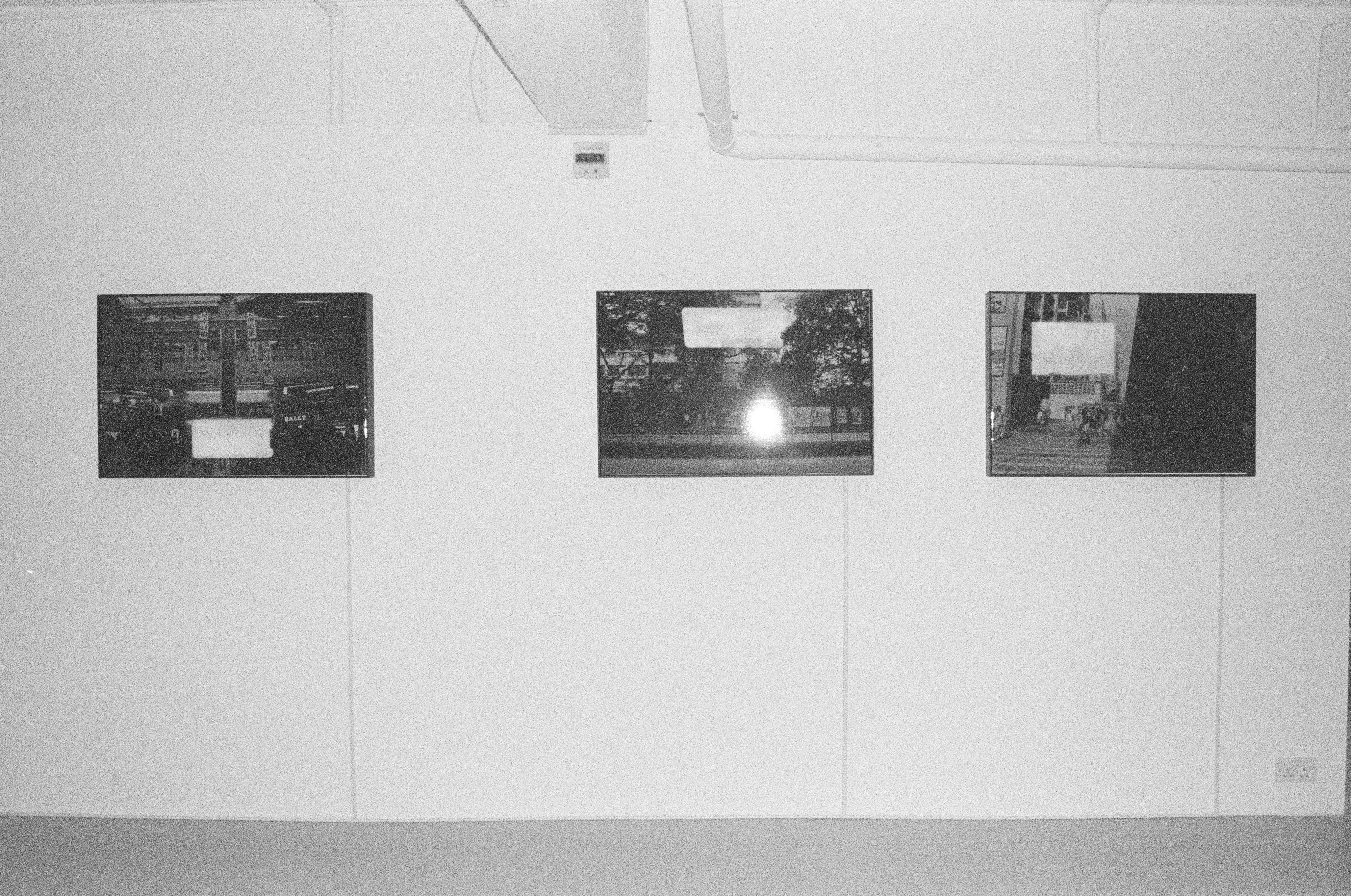ScreenSlaver
>Related Artwork
Screenslaver (Void), 2020
Screenslaver (Mask), 2020
Screenslaver (*), 2018 - 2020
> Leaflet
Screenslaver (Void), 2020
Screenslaver (Mask), 2020
Screenslaver (*), 2018 - 2020
> Leaflet

















New Light exhibition scheme set out to be a platform for nurturing young local photographers as well as introducing new talents to the scene. Each year, a potential artist is selected through open call and provided with full support in debuting their solo exhibition in Lumenvisum’s gallery space. Reviewed by a professional panel of judges, this year the awarded emerging artist is Wong Pak Hang. His exhibition is 'ScreenSlaver'.
為扶掖本地青年攝影人才成長,「光影作坊」於2010年策劃「New Light – 青年攝影創作系列」,每年發掘具潛質的年輕攝影藝術家,為其舉辦首個個人展覽,助他們踏上藝術家之路。本年度,「光影作坊」將與本地青年藝術家黃百亨舉辦個人展覽《茫》。藝術家在其創作的路上從攝影及社會運動的關係開闢討論,探索攝影的本質,嘗試把集體的傷痕及社會的缺失以藝術作品「再現」。
在攝影興起的時候,人們看到比繪畫更真實的媒介。但發展至影像氾濫的電腦時代,攝影術由類比轉為數碼,而「捕捉現實」的特性,在轉為數碼影像後卻可以被輕易處理及修改,為「真實影像」的創作提供了更多可能性。透過現實影像的挪用及傳化,創作更多與時代相關的作品。Robert Capa提過: 「如果你的照片不夠好,表示你離得不夠近。」但藝術家的創作卻與時間與空間保持距離,重現最接近的「真實」。
藝術家於平常日子重訪社會運動重要衝突現場並利用雙重曝光方式拍攝地方日常,以長曝拍下播放著當時衝突現場直播片的屏幕。白色方形的模糊發光畫面記錄著時間的流逝,影像所指向的不單只是一張照片,更多的是群眾對影像的集體回憶和想像。畫面的細節可能模糊了,但記憶可能消逝,情緒卻會累積。過盛的影像資訊,在作品中變成茫茫一片光。藝術家又以錄像方式呈現社區中在牆上塗鴉的表達,縱然圖像已經不能閱讀,卻以流動影像方式重現。藝術家以攝影串連空間及時間,把情緒轉化為藝術。
「光影作坊」將於2020年5月呈獻《茫》黃百亨個展。這是青年藝術家黃百亨於香港的首個個人展覽,展出其攝影及錄像裝置。藝術家從攝影的本質出發,以其創作為攝影賦予新的定義。攝影具有影像傳播的功能性不會停止,由被懷疑至解讀為判決,攝影尚有很多可能性。
在攝影興起的時候,人們看到比繪畫更真實的媒介。但發展至影像氾濫的電腦時代,攝影術由類比轉為數碼,而「捕捉現實」的特性,在轉為數碼影像後卻可以被輕易處理及修改,為「真實影像」的創作提供了更多可能性。透過現實影像的挪用及傳化,創作更多與時代相關的作品。Robert Capa提過: 「如果你的照片不夠好,表示你離得不夠近。」但藝術家的創作卻與時間與空間保持距離,重現最接近的「真實」。
藝術家於平常日子重訪社會運動重要衝突現場並利用雙重曝光方式拍攝地方日常,以長曝拍下播放著當時衝突現場直播片的屏幕。白色方形的模糊發光畫面記錄著時間的流逝,影像所指向的不單只是一張照片,更多的是群眾對影像的集體回憶和想像。畫面的細節可能模糊了,但記憶可能消逝,情緒卻會累積。過盛的影像資訊,在作品中變成茫茫一片光。藝術家又以錄像方式呈現社區中在牆上塗鴉的表達,縱然圖像已經不能閱讀,卻以流動影像方式重現。藝術家以攝影串連空間及時間,把情緒轉化為藝術。
「光影作坊」將於2020年5月呈獻《茫》黃百亨個展。這是青年藝術家黃百亨於香港的首個個人展覽,展出其攝影及錄像裝置。藝術家從攝影的本質出發,以其創作為攝影賦予新的定義。攝影具有影像傳播的功能性不會停止,由被懷疑至解讀為判決,攝影尚有很多可能性。
'Void'
By Tam Wai Ping, 18 April 2020
In this era overwhelmed with digital media, massively produced images are continuously spread through the Internet without the restrictions of time and space. The images have surpassed physical limitations and has become an incantation of the human spirit.
Since the social movement last year in Hong Kong, the images that have been widely circulated on the Internet are those that are extremely provocative, and have caused great pain, resentment, and anger, leaving a permanent echo in our hearts. These kinds of images make me wonder how I should face the situation. The more emotions I suppress, the more guilty I feel. The more I reason, the more helpless I feel. If I choose to be an ignorant bystander, then I am only trying to evade the matter and that is an unforgivable sin of mediocrity. What is the purpose of creating those images? For documentation? For the witness of violence? Or is it a surveillance of violence? And could surveillance become violence? Would it be transformed into a propagation that incites even more violence? Will we soon become numb to these daily doses of ‘violent images’? Therefore I reflect on whether these images actually help us think, or does it make us ‘at a loss for words’ instead.
Through the photography series ‘Screenslaver (Void)’ by Wong Pak Hang, I found some inspiration. In the face of the most turbulent moments in society, he chose to take photographic records whilst keeping distance from the time and space of such moments — by taking long exposures of different screens of live broadcasts of the incidents. This is not a means to escape from the real scene, but to replicate the closest ‘reality’ by indirectly capturing continuous multi-angle viewpoints through computers, TVs, and various screens. The overexposure is in fact not a blank white space, but rather an overlay of emotions. As he has said, ‘the overwhelming amount of images and information eventually turned into a light of void’, he uses photography to record the missing part of current society.
After the violence, Wong returned to the actual sites for shooting, which presents an ironically calm daily life. The white light in the photos compels the audience to stare and recall yesterday's images. Their gaze brings the viewer back to personal experiences. The white light relaxes the tension and does not immediately relay any new information to the audience. Instead, it causes time to accumulate in front of us and allows us to slowly recall various memories of these places. The pane of white light breaks the fate of photography as only a means of capturing ”decisive moments”. Not seeking an immediate response to a moment is imperative because these short-lived moments have not helped us to sort out our inner emotions.
In this era, the definition of photography is constantly changing: it can be doubted, interpretation becomes judgment, and its propagation will not stop. Nonetheless, this ever-changing definition will still face human nature, record human emotions, and evoke human conscience. I saw these precious meanings in the artworks of Wong Pak Hang.
By Tam Wai Ping, 18 April 2020
In this era overwhelmed with digital media, massively produced images are continuously spread through the Internet without the restrictions of time and space. The images have surpassed physical limitations and has become an incantation of the human spirit.
Since the social movement last year in Hong Kong, the images that have been widely circulated on the Internet are those that are extremely provocative, and have caused great pain, resentment, and anger, leaving a permanent echo in our hearts. These kinds of images make me wonder how I should face the situation. The more emotions I suppress, the more guilty I feel. The more I reason, the more helpless I feel. If I choose to be an ignorant bystander, then I am only trying to evade the matter and that is an unforgivable sin of mediocrity. What is the purpose of creating those images? For documentation? For the witness of violence? Or is it a surveillance of violence? And could surveillance become violence? Would it be transformed into a propagation that incites even more violence? Will we soon become numb to these daily doses of ‘violent images’? Therefore I reflect on whether these images actually help us think, or does it make us ‘at a loss for words’ instead.
Through the photography series ‘Screenslaver (Void)’ by Wong Pak Hang, I found some inspiration. In the face of the most turbulent moments in society, he chose to take photographic records whilst keeping distance from the time and space of such moments — by taking long exposures of different screens of live broadcasts of the incidents. This is not a means to escape from the real scene, but to replicate the closest ‘reality’ by indirectly capturing continuous multi-angle viewpoints through computers, TVs, and various screens. The overexposure is in fact not a blank white space, but rather an overlay of emotions. As he has said, ‘the overwhelming amount of images and information eventually turned into a light of void’, he uses photography to record the missing part of current society.
After the violence, Wong returned to the actual sites for shooting, which presents an ironically calm daily life. The white light in the photos compels the audience to stare and recall yesterday's images. Their gaze brings the viewer back to personal experiences. The white light relaxes the tension and does not immediately relay any new information to the audience. Instead, it causes time to accumulate in front of us and allows us to slowly recall various memories of these places. The pane of white light breaks the fate of photography as only a means of capturing ”decisive moments”. Not seeking an immediate response to a moment is imperative because these short-lived moments have not helped us to sort out our inner emotions.
In this era, the definition of photography is constantly changing: it can be doubted, interpretation becomes judgment, and its propagation will not stop. Nonetheless, this ever-changing definition will still face human nature, record human emotions, and evoke human conscience. I saw these precious meanings in the artworks of Wong Pak Hang.
《白茫茫》
譚偉平寫於2020年4月18日
在這個影像氾濫的時代,人們海量地投入影像的製造,透過網絡不受時空限制的不斷傳發,影像穿越了物理上的限制,變為精神上的巫咒。
從上年社會運動至今,在網絡上廣泛流傳的影像,是那些刺激眼球、讓人感到傷痛、或者使人憤慨、甚至產生仇恨的影像,在心裡留下永記。這類影像使我不知如何面對,如壓抑情感則感到內疚,以理性思考變得乏力無助,選擇漠視則是逃避,只作旁觀會成為一種原罪。在這期間製造影像的目的為何?為了記錄?對暴力的見證?對暴力的監察?監察行為變為暴力?或變為傳播、煽動更多的暴力?傳播暴力會否比暴力更為暴力?或是我們對著「日常」的「影像暴力」已變得麻木無知?我在反思,影像有沒有幫助思考,或是,反而令人「失語」。
我在黃百亨的 Screenslaver (Void) 攝影系列找到啟示,在面對社會最動盪的一刻他選擇了距離 - 時間和場景的距離 - 的拍攝方式,以「長時間曝光拍下這些播放直播的各種屏幕」,這並不是逃離現場,透過電腦、電視及各種屏幕間接地拍下連續不斷的多角度視點,重現最接近的「真實」;曝光過度顯現並非空白,而是記錄真實的情感,正如他說:「過盛的影像資訊,最終變成茫茫一片光」,他以攝影記下當下社會的缺失。
暴力過後黃百亨回到現實的場景拍攝,相片呈現的那一片白光讓觀者凝視,反思在平靜日常中所掩蓋的昨日影像,這種凝視讓觀者回到個人經驗;那一片白光放鬆了緊張的「瞬間」拍攝,沒有要求觀者即時獲取甚麼的訊息;那一片白光讓時間累積,慢慢尋回種種的記憶;那一片白光打破攝影只作為捕捉「決定性瞬間」的宿命,因為追求即時性的反應並沒有幫助我們梳理內在的情感。
在這個時代,攝影的定義不斷在變:拍攝可被懷疑、解讀變為判決、傳播不會停止;而不變的意義依然是面對人性、記錄人的情感及喚起人類的良知。我在黃百亨白茫茫的影像中看見這些最寶貴的意義。
譚偉平寫於2020年4月18日
在這個影像氾濫的時代,人們海量地投入影像的製造,透過網絡不受時空限制的不斷傳發,影像穿越了物理上的限制,變為精神上的巫咒。
從上年社會運動至今,在網絡上廣泛流傳的影像,是那些刺激眼球、讓人感到傷痛、或者使人憤慨、甚至產生仇恨的影像,在心裡留下永記。這類影像使我不知如何面對,如壓抑情感則感到內疚,以理性思考變得乏力無助,選擇漠視則是逃避,只作旁觀會成為一種原罪。在這期間製造影像的目的為何?為了記錄?對暴力的見證?對暴力的監察?監察行為變為暴力?或變為傳播、煽動更多的暴力?傳播暴力會否比暴力更為暴力?或是我們對著「日常」的「影像暴力」已變得麻木無知?我在反思,影像有沒有幫助思考,或是,反而令人「失語」。
我在黃百亨的 Screenslaver (Void) 攝影系列找到啟示,在面對社會最動盪的一刻他選擇了距離 - 時間和場景的距離 - 的拍攝方式,以「長時間曝光拍下這些播放直播的各種屏幕」,這並不是逃離現場,透過電腦、電視及各種屏幕間接地拍下連續不斷的多角度視點,重現最接近的「真實」;曝光過度顯現並非空白,而是記錄真實的情感,正如他說:「過盛的影像資訊,最終變成茫茫一片光」,他以攝影記下當下社會的缺失。
暴力過後黃百亨回到現實的場景拍攝,相片呈現的那一片白光讓觀者凝視,反思在平靜日常中所掩蓋的昨日影像,這種凝視讓觀者回到個人經驗;那一片白光放鬆了緊張的「瞬間」拍攝,沒有要求觀者即時獲取甚麼的訊息;那一片白光讓時間累積,慢慢尋回種種的記憶;那一片白光打破攝影只作為捕捉「決定性瞬間」的宿命,因為追求即時性的反應並沒有幫助我們梳理內在的情感。
在這個時代,攝影的定義不斷在變:拍攝可被懷疑、解讀變為判決、傳播不會停止;而不變的意義依然是面對人性、記錄人的情感及喚起人類的良知。我在黃百亨白茫茫的影像中看見這些最寶貴的意義。
Artist Statement
The city can never go back to how it was before. In the past months, the streets have turned into political sites. Walls, bricks, glass, and railings now have received an all new meanings. Oppression, privilege, and resistance have all diffused into the air. Still, the truth and emotion can spread through the air, especially in the generation of live streaming. Through the screens, images allow us to see the view, feel the mood, be at the front line, and to stand together. This place we call home has become the stage of political confrontation. Fear, violence, and blood have all become a tangible reality here. After going through this kind of life, we will never live a normal day again. It has created a void that will always be in our hearts. The ‘Screenslaver' series which started since 2017, is an experiment using digital screens and analog photography, presenting the connection between our cityscape and social phenomenon. The series includes 'Augmented Suns', 'Virtual Time', '*', 'Void’, and 'Mask'. The latter two will be presented in this exhibition. |
藝術家自述
這個城市再也無法回到過去。 一年間,每大街小巷都變成了政治地標,一磚一瓦都被賦予另一重意義。 壓迫、權威和反抗存在於無形的空氣之中。
通過一個個發光的屏幕,我們可以看到同一的風景,感受同一心情,甚至成為了前線,站在一起。 我們居住的地方成為政治抗爭的場所, 恐懼、暴力、血腥曾真真確確的在這裏發生。生活從此不再一樣,有種缺失將永遠置於我們心中。
'Screenslaver' 系列從2017年起創作,是數碼屏幕對照類比 (Analog) 攝影的各種實驗,繼而連繫到城市景象及社會狀態。系列包括 'Augmented Suns'、'Virtual Time'、'*'、以及是次展出的 'Void' 和 'Mask'。
這個城市再也無法回到過去。 一年間,每大街小巷都變成了政治地標,一磚一瓦都被賦予另一重意義。 壓迫、權威和反抗存在於無形的空氣之中。
通過一個個發光的屏幕,我們可以看到同一的風景,感受同一心情,甚至成為了前線,站在一起。 我們居住的地方成為政治抗爭的場所, 恐懼、暴力、血腥曾真真確確的在這裏發生。生活從此不再一樣,有種缺失將永遠置於我們心中。
'Screenslaver' 系列從2017年起創作,是數碼屏幕對照類比 (Analog) 攝影的各種實驗,繼而連繫到城市景象及社會狀態。系列包括 'Augmented Suns'、'Virtual Time'、'*'、以及是次展出的 'Void' 和 'Mask'。